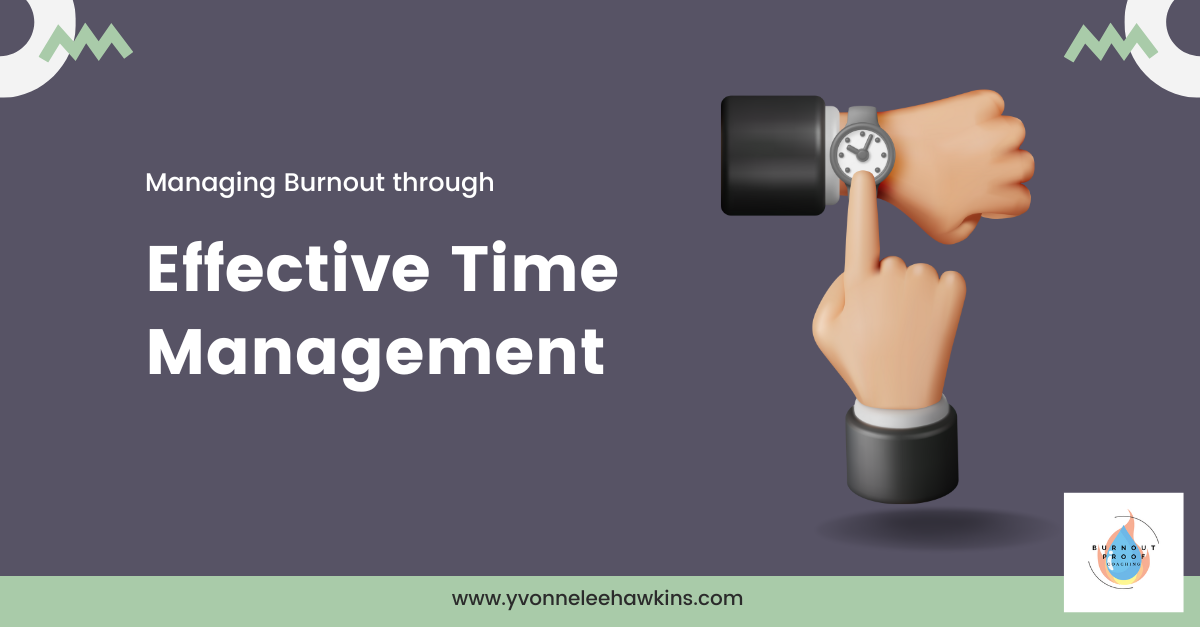Burnout is a significant issue faced by professionals today.
I’d go as far as to say it is a matter of “when,” not “if” someone experiences
burnout. It shows up in physical, emotional, and mental exhaustion, and is
generally caused by chronic stress and overwork. In previous weeks we already
discussed the benefit of ‘Focus’
and ‘Goal
Setting’ to help offset burnout. So,
if you haven’t read those yet, it’s worth to go back when you have time and
review them.
This week let’s show the benefits of proper time management
to prevent burnout. By using specific strategies to organize and prioritize
tasks, you can regain control over your schedule, reduce stress, and ultimately
prevent burnout. In this article, we will explore various time management
techniques and provide actionable steps you can take if you’re feeling
overwhelmed.
Prioritize Your Tasks
Strategy: One of the first steps in effective time
management is learning to prioritize tasks based on their urgency and
importance. Tools like the Eisenhower Matrix are excellent for this purpose.
Example: Consider a project manager juggling multiple
deadlines. By categorizing tasks using the Eisenhower Matrix, the manager can
focus on urgent and important tasks first, such as completing a project
proposal, rather than attending a less critical meeting. This method not only
helps in staying organized but also reduces the stress associated with feeling
overwhelmed by too many tasks.
Action to take: If you’re feeling burned out, start by
listing all your tasks. I call this
“brain dumping.” Take everything that is
weighing on your mind, work or personal things, everything you need to do and
get it down on paper. Once it’s all
there, start to prioritize them. Focus on what are the most important tasks
first. What do you personally have to do?
What can you ask others to do?
What can wait until the important tasks are done? This will give you a
sense of control and accomplishment once you are able to complete a task or
two. It will also help reduce pressure and anxiety.
Implement Time Blocking
Strategy: Time blocking involves dividing your day into
dedicated blocks of time for specific tasks or activities. This method ensures
that you give enough time to complete important tasks without distractions.
Example: A software developer might block out time in the
morning for coding, reserve midday for meetings, and use the afternoon for
project planning. This focused approach minimizes task-switching, which can be
mentally exhausting, and helps maintain a steady workflow.
Action to take: Try setting up a time-blocking schedule for your workday. Reserve blocks of time for your most important tasks and stick to them. Be mindful of what time of day is your best “thinking time.” For example, when I am writing I tend to have my best thinking energy early in the day, before it’s been zapped by tending to kids, clients, and other life stuff. Late afternoon is best for me to be social. Your times may be different, but it is good to figure it out. This structured approach can help you stay focused and make the most of your workday based on your natural rhythms and energy levels.
Delegate Tasks
Strategy: Delegation is key to preventing burnout. No one
can do it all by themselves. By assigning tasks to others when appropriate, you
can free up time for high-priority work and reduce your overall workload. It
also helps you to build trust and connection with those who you trust enough to
delegate.
Example: Imagine a manager who has too much on their plate.
By delegating routine tasks like data analysis to a team member, the manager
can focus on strategic planning and decision-making, which are more critical to
the team’s success. This not only helps in managing workload but also creates
team collaboration.
Action to take: Identify tasks that you can delegate to
others. Whether it’s at work or at home, sharing responsibilities can lighten
your load and reduce stress. Don’t be afraid to ask for help when you need it. I can attest that life has become so much
better now that my kids do their own laundry and help with chores. They may not
do them perfectly, but you have to learn to pick your battles. Also, my
marriage is stronger because I’ve involved and asked for help from my partner
in everything from financials to parenting. Now, we have a much more united
feeling of being “in it together.”
Use the Pomodoro Technique
Strategy: The Pomodoro Technique is a time management method
that involves setting a time to do work for 25 minutes, then taking a 5-minute
break. After four “Pomodoros,” take a longer break. It is a good way to manage the time you have
blocked. Note: I’ve heard from
several folks, especially ones that have ADHD, that Pomodoro doesn’t work well
for them. That’s ok. It’s just one timing strategy. If it doesn’t work for you,
don’t do it. Find one that works better for your specific needs.
Example: A student studying for exams uses the Pomodoro
Technique to maintain concentration. By breaking study sessions into manageable
chunks with regular breaks, the student can stay focused without becoming
overwhelmed.
Action to take: If you’re struggling with concentration or
feeling overwhelmed, try the Pomodoro Technique. Break your work into 25-minute
intervals with short breaks. This method can help you keep focus and prevent
mental fatigue. I also like to put
“focus music” in the background or use binaural beats using headphones to help
me focus. You can simply search for
“binaural beats for focus” on your favorite streaming platform like Amazon
Music or Spotify and try it for yourself.
Set Clear Boundaries
Strategy: Setting up boundaries between work and personal
life is crucial for maintaining a healthy work-life balance. This includes
setting specific work hours and sticking to them. I know, I know, you’ll say, “but Yvonne, I’m
salaried. I often have to do work during
non-standard business hours.” I’m not
saying never do work that isn’t done during 9-5. BUT, and it’s a big but, understand the
difference between having a flexible schedule and not being able to turn
off. If you are putting in a full day
already, and then also have to attend to work due to unplanned emergencies,
escalations, or issues, it’s time to evaluate if you need more resources,
better priorities, or possibly a different job.
A mentor once told me “If everything is important, then nothing is. And if your leadership isn’t able to tell the
difference, then they aren’t leaders worth following.”
Example: A remote employee might set a rule to stop working
at 6 PM and avoid checking work emails after that time. These boundaries
prevent work from taking over personal time, which is essential for mental and
emotional well-being.
Action to take: Set clear boundaries between your work and
personal life. Decide on a time to stop working each day and stick to it. It’s
particularly good to have a “shut down” ritual.
It could be as simple as closing your laptop and pushing your chair
under your desk. But a physical ritual
signals to your brain that it is time to stop thinking about work and switch to
home life mode. This will help you disconnect from work and recharge.
How These Strategies Help Prevent Burnout
These time management strategies can have a big impact on
your overall well-being. By prioritizing tasks, blocking time, delegating, and
setting clear boundaries, you can create a more balanced and manageable work
schedule. Here are key benefits of adopting these strategies:
·
Improved Focus and Efficiency: Time management
techniques like time blocking and the Pomodoro Technique help you concentrate
on one task at a time. This focus increases efficiency and reduces the mental
load of multitasking.
·
Reduced Stress and Overwhelm: Prioritizing tasks
and setting clear boundaries can significantly lower stress levels. When you
know what needs to be done and have a plan in place, the uncertainty and
anxiety that contribute to burnout are reduced.
·
Better Work-Life Balance: By setting boundaries
and taking regular breaks, you prevent work from bleeding into all of your time
and using all your energy. This balance is critical for keeping overall
well-being and preventing burnout.
·
Increased Sense of Control: When you use time
management strategies like delegation and daily planning, you gain more control
over your workload. This sense of control can enhance job satisfaction and
reduce feelings of helplessness.
·
Enhanced Productivity: Focusing on one task at a
time and minimizing distractions leads to higher quality work and faster
completion times. This productivity boost can reduce the time spent on work,
leaving more time for rest and personal activities.
Take Action Now
If you’re experiencing burnout or feel like you’re on the
verge of it, now is the time to take action. Start experimenting with these
time management strategies today. By making small changes in how you manage
your time, you can significantly improve your productivity, reduce stress, and
create a healthier work-life balance. By adopting these strategies, you can
regain control over your schedule, reduce the risk of burnout, and create a
more balanced and fulfilling life. Your time is valuable—how you spend it
determines how you spend your life. Take charge of your time management and
protect your well-being. Time management
is a professional form of self-care.
Remember, Self-care isn’t selfish…it’s required.
And if you are too burned out and overwhelmed to even begin
to use any of these strategies it might be time to get some help. Find a coach,
therapist, or doctor who can help you reverse out of the physical, mental, and
emotional symptoms of burnout so you can get back to living in healthy balance.
Let me know if this topic added value for you. Please like
and subscribe if you want more wellness topics like this. Also tell me what
other wellness topics you’d like to read about by commenting or DM’ing me. I
always love suggestions and feedback!
Yvonne Lee-Hawkins, IPHM, is a holistic wellness coach,
stress strategist, and writer. When she is not working, she loves to go on
nature adventures with her family, in the Pacific Northwest where they call
home. You can find out more on her website, or follow her
on LinkedIn,
Medium, or Instagram.
If you want some help with time management, Burnout
recovery or general wellness, book a call here.

